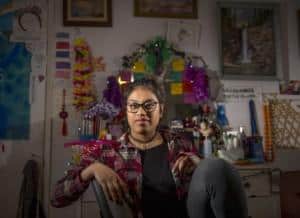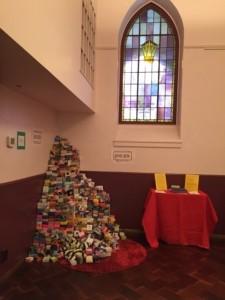
Kids to Know: The Climate Change Challengers
For Beaverton siblings Miko and Isaac Vergun, climate change is not some abstract idea. It’s personal and it’s a family affair. “Since I was born in the Republic of the Marshall Islands, it is very important to me to keep small islands nations like the Marshall Islands from going underwater,” says 17-year-old Miko. Miko and Isaac are two of the 21 children and young adult plaintiffs in Juliana v. United States, a federal lawsuit put forth in 2015 that asserts that the government has caused climate change and is thereby violating the plaintiffs’ right to life, liberty and property. The suit has faced significant pushback from the federal government and the fossil fuel industry, but is currently scheduled to be heard before U.S. District Court Judge Ann Aiken in Eugene on October 29, 2018.

“By being a plaintiff in the federal case Juliana et al. v. United States — plus with the work I am doing through Plant-for-the-Planet — I have an incredible chance to make a difference to protect the future of the world, as well as my sister’s birth country, countries across the world where I increasingly have friends, and even my very ability to keep my asthma from getting worse,” says 16-year-old Isaac. Miko and Isaac are not the only ones concerned for the planet in their family; their mother was also very involved with bringing Plant for the Planet, a nonprofit from Germany that teaches children how to combat the climate crisis and aims to plant 1 trillion trees, to Oregon and Southwest Washington, too. — Denise Castañon
Bookshelf: Picture This
Reading a beautifully illustrated books with your kids is like stepping into another world for a few moments. Here, Kim Tano and Richard Corbett, the children’s book buyers for the iconic Powell’s Books in Portland, share their picks for the best new picture books of 2018 (so far).
Hello Lighthouse, written and illustrated by Sophie Blackall
From the illustrator of the Ivy & Bean series comes this peaceful look at life inside a lighthouse. While the water churns and recedes outside, inside the keep and his family make tea, keep a logbook and make sure the lamp’s wick stays alight. $18.99.
Ocean Meets Sky, written and illustrated by Terry Fan and Eric Fan
Grown-ups might call it the horizon. But kids know it’s really the place where the ocean meets the sky. And so a young boy sets sail on a pilgrimage to honor his grandfather, accompanied by whales and jellyfish, seagulls and clouds. $17.99.
They Say Blue, written and illustrated by Jillian Tamaki
You can see with your own eyes that an egg yolk is yellow, and that your blood is red, and that the crocus that appear in spring are purple. But when you try to cup water in your hands, it isn’t blue — so how can you be sure? A gentle book about learning your colors and asking questions. $17.99.
Forever or a Day, written and illustrated by Sarah Jacoby
An ode to appreciating where you are right now, this warm, quietly illustrated book explores the elusive meaning of the word “forever.” Unfolding as a conversation between a parent and a child over the course of a single day, this one reminds us to be grateful for the smallest of moments. $17.99.
Florette, written and illustrated by Anna Walker
Mae’s family has moved from their verdant country home to Paris, and she’s longing for her old garden, where she once chased butterflies and watched the plants grow. There seems to be no green space in the city — until one day, Mae finds a way. Walker’s lush illustrations help inspire hope where there seemed to be none. $16.99.
Drawn Together, written by Minh Lê, illustrated by Dan Santat
This simply told tale with few words and colorful, elaborate illustrations, tells the story of a grandfather and grandson who don’t speak each other’s language. But over the course of the book, the two find that art brings them together. A lovely reminder that there are many ways to communicate and form friendships. $17.99.
Chalkboard: Reality Show
21 percent of families with kids ages 18 and under own a virtual reality device.
13 percent expect to buy one in the next year.
43 percent of parents say it is appropriate for kids under the age of 13 to use VR.
Among kids ages 8-17 who have used virtual reality, 76 percent say they have used it to play games.
Is virtual reality, better known as VR, the next big item on your kid’s wish list? A new study by Common Sense Media suggests that the VR experience — in which people don a special headset to simulate an environment — is making slow but steady incursions into the family market. The study suggests that parents have real concerns about VR, including that it could increase social isolation and access to inappropriate content, plus leave kids wanting to spend more and more time on it (as opposed to going outside, into actual reality). On the flip side, the study showed that parents are cautiously optimistic about the education potential of virtual reality, with 62 percent of parents saying they think it can provide an educational experience for kids; that number climbs to 84 percent among parents whose kids are already experimenting with the technology. After all, VR can help a child feel like they are soaring through space, or exploring underwater or trekking through the desert, without ever leaving home. But its most common application right now? Playing games, according to the survey results. Watch those wish lists … . — J.S.

Good Deeds: The Soul Box Project
After the November, 2016 presidential election, Southwest Portland resident Leslie Lee’s anxiety climbed so high that she broke out in a rash “from my knees to my neck.” She tried putting herself on a news diet, but when a gunman opened fire at a concert in Las Vegas in late 2017, killing 58 people and injuring hundreds more, she knew she couldn’t just look away.
So instead, Lee is spearheading an effort to force people to engage with the reality of gun violence in the United States. She’s the founder of The Soul Box Project, which aims to create a tiny origami box to memorialize each and every one of the people whose lives were lost to gun violence in this country between 2014-2017. (That’s 168,558, for those keeping track at home.) She began in October of 2017; now she’s getting thousands of boxes donated each month, and has a date to put 35,000 of them on display at the state Capitol in Salem in February of 2019, right around the anniversary of the shooting at Marjory Stoneman Douglas High School in Parkland, Fla.
“This happened with the AIDS quilt too,” Lee says. “They created something beautiful about a horrific subject. And to have the kids have some way of tangibly expressing and understanding what this issue is about is really valuable. Someday, they will see these exhibits and say, ‘Oh my gosh, I helped with this.’”
Want to help? You can organize a box-making party at home, or attend a session at a local library or place of worship. Lee’s website, soulboxproject.org, has simple-to-follow directions on how to make the boxes, and kids can decorate them any way they like. She’s looking for board members too, and folks to help out with social media. (Follow them at @soulboxproject on Facebook, Instagram and Twitter.) Get in touch at soulboxteam@gmail.com. — J.S.
Ask Dr. Corey
Q: I recently read a pretty alarming report about levels of arsenic in rice cereal. We were thinking about making that our daughter’s first solid food. What’s your advice on the best first food for babies, and how to progress from there?
A: Providing food for our families is a basic human instinct. Aside from the obvious importance of providing nutrition for growing and development, meal time is a shared cultural experience.
Because of this importance, it’s always alarming when scary things show up in our food, whether that’s an outbreak of something like salmonella or a “heavy metal” like arsenic.
There are two kinds of arsenic that show up in food. One kind, which occurs naturally and is not thought to be dangerous, is called “organic arsenic.” It’s the other kind, “inorganic arsenic,” that we worry about.
Too much exposure to inorganic arsenic can cause vomiting, other stomach problems, or problems with the brain, heart, or even certain types of cancer. Typically, one would have to be working directly with pure arsenic, and either eating it or not handling it safely for these types of problems to occur.
The American Academy of Pediatrics is working with the Food and Drug Administration to help set rules for how much arsenic is allowed in food. Great guidance for parents concerned about this issue can be found at healthychildren.org.
I always tell parents that iron-containing solid foods should be introduced by 6 months of age, but that rice cereal doesn’t have to be the first food, or introduced at all for that matter. There are many other single-grain cereal (like oat or barley or wheat) that are iron-fortified. Finely chopped meat (if your family eats meat, of course) is a great source of iron. Also, feel free to start with a puréed vegetable like carrots, sweet potato, spinach or squash. The world’s your oyster! (Though maybe don’t start with oysters …)
As an aside, this will be the last Ask Dr. Corey column as I pass the torch on to my esteemed colleague, Dr. Doug Lincoln from Metropolitan Pediatrics. If you have more questions for me, feel free to email at info@pacificcrestchildrens.com or make an appointment to come see me at my pediatric-specific urgent care practice, Pacific Crest Children’s Urgent Care — more information is online at pacificcrestchildrens.com.
- May 2024 Digital Issue - April 23, 2024
- Tween/Teen Summer Camps & Jobs - April 22, 2024
- Featured Camp of the Week: Classical Ballet Academy - April 22, 2024






